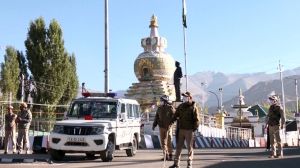US mulls new power grid
As water here became drinkable again and electricity returned to all but a few thousands of people affected by last week’s blackout, po...

As water here became drinkable again and electricity returned to all but a few thousands of people affected by last week’s blackout, policy makers and industry officials on Sunday debated how to improve the nation’s aging and underpowered electrical grid.
At the same time, the utility that owns Ohio transmission lines suspected of triggering the blackout said glitches in its system alone probably did not account for the failure. Akron-based First Energy Corp said problems in the East Coast Interconnect, the main grid east of Rocky Mountains, began appearing around Thursday, two hours before its first plant went off-line and four hours before the blackout.
‘‘Based on what we know now, changes were occurring elsewhere — frequency and voltage fluctuations, and load swings,’’ said First Energy spokeswoman Kristen Baird. ‘‘Clearly, there were some unusual conditions in the region, not just our system. What happened that day seems to be far more complex than a few tripped power lines.’’
The head of the group that seeks to keep electricity flowing cautioned against blaming First Energy, saying problems at other power entities might also have fueled the outages. ‘‘Although we may have identified the area where the cascading outages began, any attempt to identify the cause … would be speculative and premature,’’ said Michehl R. Gent, president and CEO of the North American Electric Reliability Council, or NERC.
On Sunday, the Bush administration called on Congress to require that utilities either comply with reliability standards designed to keep electricity flowing or face sanctions. NERC, which was created following a major blackout in Northeast in 1965, has been asking Congress for two years to enforce the standards.
Another problem in the largely deregulated utility marketplace has been convincing utilities to invest in new lines, power plants and other infrastructure. Energy Secretary Spencer Abraham said: ‘‘The people who benefit from the system have to be part of the solution here. That means the rate-payers are going to have to contribute. Consumers will eventually pay up to $50 billion in higher electric bills to modernise the nation’s ailing power transmission system’’
FERC, has sought to construct a system of regional grid managers, which it argues would improve the flow of power nationwide. On Sunday, the administration said it would seek at least a three-year delay of such a system, which is already opposed by several states, especially in the South and Northwest. (LAT-WP)





- 01
- 02
- 03
- 04
- 05


























